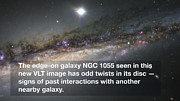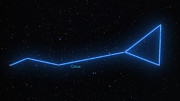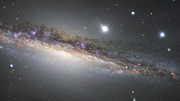The edge-on spiral galaxy NGC 1055 in the constellation of Cetus (The Sea Monster)
Videos

ESOcast 98 Light: A Galaxy On Edge (4K UHD)

Zooming in on the edge-on galaxy NGC 1055


Panning across a new image of NGC 1055
Links
This colourful stripe of stars, gas, and
dust is actually a spiral galaxy named NGC 1055. Captured here by ESO’s
Very Large Telescope (VLT), this big galaxy is thought to be up to 15
percent larger in diameter than the Milky Way. NGC 1055 appears to lack
the whirling arms characteristic of a spiral, as it is seen edge-on.
However, it displays odd twists in its structure that were probably
caused by an interaction with a large neighbouring galaxy.
Spiral galaxies throughout the Universe take on all manner
of orientations with respect to Earth. We see some from above (as it
were) or “face-on” — a good example of this being the whirlpool-shaped
galaxy NGC 1232.
Such orientations reveal a galaxy’s flowing arms and bright core in
beautiful detail, but make it difficult to get any sense of a
three-dimensional shape.
We see other galaxies, such as NGC 3521,
at angles. While these tilted objects begin to reveal the
three-dimensional structure within their spiral arms, fully
understanding the overall shape of a spiral galaxy requires an edge-on view — such as this one of NGC 1055.
When seen edge-on, it is possible to get an overall view of how stars — both new patches of starbirth
and older populations — are distributed throughout a galaxy, and the
“heights” of the relatively flat disc and the star-loaded core become
easier to measure. Material stretches away from the blinding brightness
of the galactic plane itself, becoming more clearly observable against
the darker background of the cosmos.
Such a perspective also allows astronomers to study the
overall shape of a galaxy’s extended disc, and to study its properties.
One example of this is warping, which is something we see in NGC 1055.
The galaxy has regions of peculiar twisting and disarray in its disc,
likely caused by interactions with the nearby galaxy Messier 77 (eso0319) [1]. This warping is visible here; NGC 1055’s disc is slightly bent and appears to wave across the core.
NGC 1055 is located approximately 55 million light-years away in the constellation of Cetus (The Sea Monster). This image was obtained using the FOcal Reducer and low dispersion Spectrograph 2 (FORS2) instrument mounted on Unit Telescope 1 (Antu) of the VLT, located at ESO’s Paranal Observatory in Chile. It hails from ESO’s Cosmic Gems programme,
an outreach initiative that produces images of interesting, intriguing
or visually attractive objects using ESO telescopes for the purposes of
education and outreach.
Notes
Notes
[1] Messier 77, also known as NGC 1068, has a very brilliant central
region powered by a supermassive black hole. It is one of the nearest
examples of what astronomers call active galaxies.
More Information
More Information
ESO is the foremost intergovernmental astronomy organisation in Europe
and the world’s most productive ground-based astronomical observatory by
far. It is supported by 16 countries: Austria, Belgium, Brazil, the
Czech Republic, Denmark, France, Finland, Germany, Italy, the
Netherlands, Poland, Portugal, Spain, Sweden, Switzerland and the United
Kingdom, along with the host state of Chile. ESO carries out an
ambitious programme focused on the design, construction and operation of
powerful ground-based observing facilities enabling astronomers to make
important scientific discoveries. ESO also plays a leading role in
promoting and organising cooperation in astronomical research. ESO
operates three unique world-class observing sites in Chile: La Silla,
Paranal and Chajnantor. At Paranal, ESO operates the Very Large
Telescope, the world’s most advanced visible-light astronomical
observatory and two survey telescopes. VISTA works in the infrared and
is the world’s largest survey telescope and the VLT Survey Telescope is
the largest telescope designed to exclusively survey the skies in
visible light. ESO is a major partner in ALMA, the largest astronomical
project in existence. And on Cerro Armazones, close to Paranal, ESO is
building the 39-metre European Extremely Large Telescope, the E-ELT,
which will become “the world’s biggest eye on the sky”.
Links
Contacts
Richard Hook
ESO Public Information Officer
Garching bei München, Germany
Tel: +49 89 3200 6655
Cell: +49 151 1537 3591
Email: rhook@eso.org
ESO Public Information Officer
Garching bei München, Germany
Tel: +49 89 3200 6655
Cell: +49 151 1537 3591
Email: rhook@eso.org
Source: ESO


